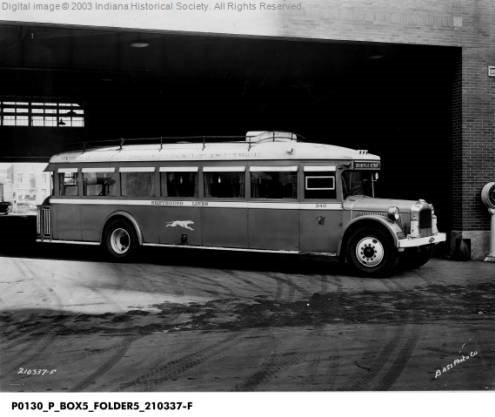
On November 19, 1927 Laura Fisher boarded a Greyhound Bus at a station in Richmond, Indiana. The African American passenger, destined for her hometown of Cincinnati, Ohio, felt ill and took a seat at the front of the bus where it was warmest. This infuriated the Cincinnati bus driver Glen Branoski, described in the newspapers as “of foreign descent,” who demanded Fisher sit in the back of the bus in the section he had designated as “negro.” After refusing to move, Branoski ejected Fisher from the bus. According to a November 29, 1927 article in the Richmond Item, Fisher re-entered the bus, which prompted Branoski to call police headquarters. The Richmond Palladium [originally the Palladium and Sun-Telegram] noted that he demanded that the police remove her, citing that “Jim Crow rule” was “provided by the [bus] company.” Even though Greyhound was headquartered in Duluth, Minnesota, the growing interstate bus line needed to be mindful of the regional laws regarding segregation.
Jim Crow laws “came to mean any state law passed in the South that established different rules for blacks and whites. Jim Crow laws were based on the theory of white supremacy and were a reaction to [Civil War] Reconstruction.” Historian Richard B. Pierce noted that Indiana “did not have as complete a system of Jim Crow” as southern states, although it “did have its own unique brand of discrimination.” In Fisher’s case, the police station cited that “state laws did not legalize such discrimination and the police department had no authority to help” Branoski enforce the bus line policy.
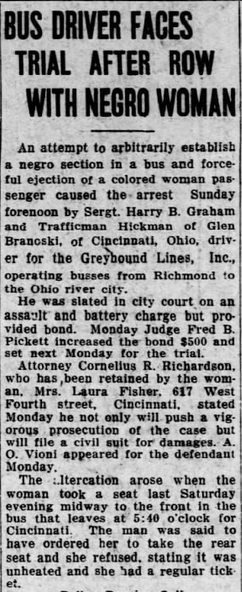
The Richmond Item reported that following this refusal, Branoski ejected Fisher a second time “with such violence that she was painfully injured” and then he tore up her ticket. The paper noted, “A considerable crowd collected and trouble threatened for a time, Mrs. Fisher becoming almost hysterical from fright.” Had police officers not arrived in a timely manner, the newspaper predicted, there would likely have been a riot. This unlawful attempt to enforce of Jim Crow segregation led to Branoski’s arrest the day following the incident. An Item article reported that on November 21 he plead “not guilty” to assault and battery and was released on bond, ordered to report to city court the following Monday for trial.
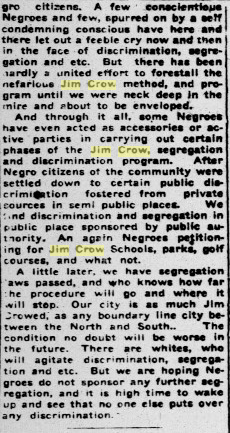
Several local newspapers noted that this “Jim Crow” trial was the first racial discrimination case Richmond had encountered in many years. However, Fisher’s experience typified increasing segregation in Indiana during the mid and late 1920s. According to Emma Lou Thornbrough’s Indiana Blacks in the Twentieth Century, in 1927 a wave of racial discrimination led to the authorization or opening of segregated Indiana schools, including Indianapolis’s Crispus Attucks High School, Gary’s Roosevelt School, and Evansville’s Lincoln School. Each of these were barred from membership in the Indiana High School Athletic Association, on the grounds that the schools were not “publicly open to all” (the rule also barred parochial schools from IHSAA membership by the same rationale). The rule was in effect until 1942, and prohibited all-black squads from competing against white teams.
Segregation also extended to recreation, housing, and medical care. According to historian James Madison, nearly every facet of Hoosier life in the post-WWI era was segregated or exclusionary, including “theaters, public parks, cemeteries, restaurants, hotels, beaches, swimming pools, orphans’ homes, hospitals, newspaper society columns, the state militia . . .” A March 15, 1927 article in the Huntington Herald demonstrates the attitudes of those Hoosiers calling for segregation, alleging “the average negro, given an inch will take a mile” and therefore “it is the negro’s mode of living that has resulted in the passage of all Jim Crow laws.”

However, Madison noted that “Indiana blacks did not accept discrimination and segregation without protest,” evinced by Laura Fisher’s case. On November 28, Branoski reported for trial at the city court, where he gave no testimony and plead guilty to assault and battery (Richmond Palladium). He was fined $50, plus costs, and 20 days in county jail. The bus company, which fired Branoski but paid his fines, settled out of court with Fisher and paid her $500 to sign a “release from a damage action which had been threatened.” According to the November 29 Richmond Item article, Fisher took Branoski to court with the purpose of obtaining racial justice, rather than financial settlement. One of her lawyers stated that:
‘Negro residents of the community were not asking for the imposition of any severe penalty upon Branoski, merely a vindication of equal rights of Negro passengers with white passengers on public transportation conveyances. He several times asked Branoski’s jail sentence be reduced to 10 days.’
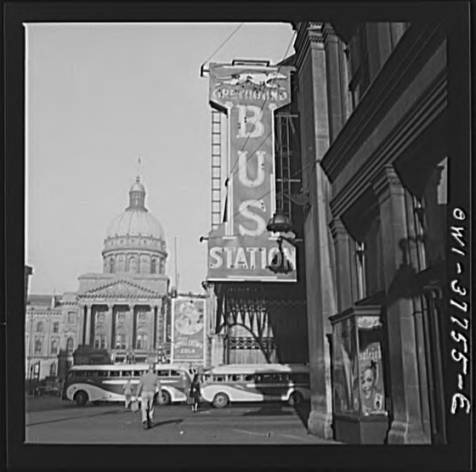
In announcing the verdict, Richmond police judge Fred Pickett stated that “The Indiana law on racial discrimination is clear. It does not tolerate discrimination” (Palladium, November 29). He added “Ignoring the fact that one of the principals in this case is a white man and the other a negro woman it must be viewed solely as an aggravated, unprovoked attack by a strong man upon a woman who was both weak and ill. She was both injured and humiliated.” Judge Pickett made his opinion clear, stating “I want it to be a matter of public record that this court regards an attack made by a man upon a woman a serious offense not to be lightly condoned.”

Although his statements seem to emphasize injustice based on gender, rather than race, the Freeport Journal-Standard of Illinois noted “that Indiana does not recognize a ‘Jim Crow’ rule was emphasized by police judge, Fred Pickett.”
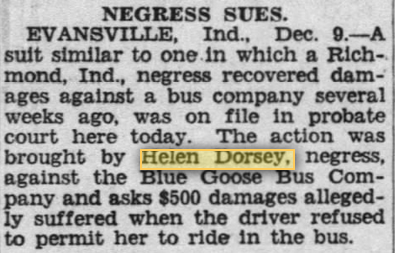
While research efforts to locate articles about the fates of Fisher or Branoski following the trial were unfruitful, the case was referenced in a similar bus incident occurring on November 23, just four days after Fisher’s ordeal. According to a December 17, 1927 article in the Indianapolis Recorder, prominent African American business woman Helen M. Dorsey filed suit against the Blue Goose Bus Line when a driver refused to let her board the bus. Unable to make it to a conference in Kentucky on time, she “arrived too late to take care of the matters.” She therefor sought $500 in damages, the amount offered to “a passenger, Mrs. Laura Fisher, at Richmond, Ind. a few weeks ago.” These 1927 cases highlighted Indiana’s increasing segregation and the daily battles African Americans waged-and sometimes won-to obtain equal privileges.
Check back February 16 to learn about Indianapolis Public Schools, residential segregation, and forced busing in the 1970s.
